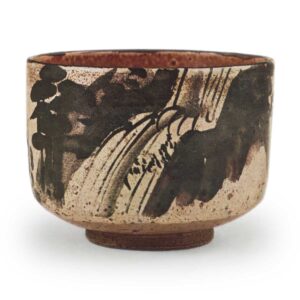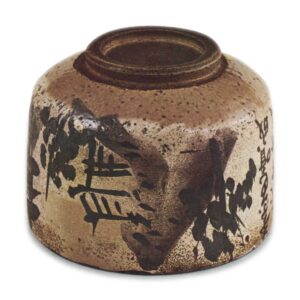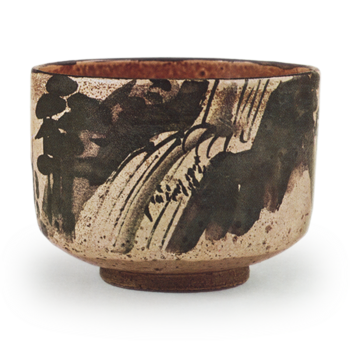

Height: 7.8cm
Diameter: 10.3cm
Height of foot ring: 5.4cm
Height of rim: 0.7cm
This is one of the most famous of Kenzan’s tea bowls, and is also one of the best works in his entire oeuvre.
While learning the techniques of Ninshō, Kenzan also developed his own unique style, establishing a new style of pottery that was completely different from Ninshō’s. While Ninshō tended to be more of a technical artisan, Kenzan’s work was first and foremost a remarkable expression of artistic spirit. He was proficient in Japanese and Chinese calligraphy and painting, and he often composed Japanese waka poems and recited Chinese poetry. He was also a connoisseur of the tea ceremony. In other words, his pottery making was the greatest outlet for his artistic passion. Naturally, his strong individuality was expressed here, and a number of elegant and tasteful ceramics with a unique style were born. This tea bowl with a waterfall and mountain landscape design is considered to be a masterpiece from the Narutaki period, when Kenzan’s spirit was soaring.
Like many other examples, the wheel-throwing was probably done by someone other than Kenzan. The shape is simple and honest, with a neat foot ring, and overall it is a plain, unremarkable half-cylindrical shape. The clay is slightly rough, and the color is a pale grayish-white with a hint of yellow, and it is fired a little strongly. The majority of Kenzan’s tea bowls are of this type, but in the case of Kenzan, who was aiming for a purely artistic effect, the plain, unobtrusive shape and clay body were more suitable.
The painting is done in black underglaze, in the style of Chinese painting. The composition is bold, with a large depiction of a torrent of water falling at a steep angle with a splash between the rocks of a valley, filling the entire side of the tea bowl, and with interestingly placed mountains, trees and pavilions added to this. The rapid, forceful brushwork of the waterfall, the expressive brushstrokes of the mountains, trees and pavilions, the deep sense of power conveyed through the interplay of light and shade, and the sense of dynamism that pervades the painting as a whole.
In the blank space around the painting, he added the inscription “The snow of the three-fold snowfall of the pure color of the spray, the aftermath of the flow of the ten thousand year ravine” in his characteristic calligraphic style.
It is not clear whether this poem was taken from a Chinese poem or was written by Kenzan himself, but it expresses the clear and cool feeling of the deep mountain valley, where the snowmelt in midsummer flows in a gourd-shaped stream.
The poem and calligraphy blend beautifully into the painting, creating a unique ink painting in the style of Kenzan.
It could also be said that Kenzan’s own pure and clear poetic heart burst forth from the tip of his brush, creating this exceptional poem and painting. The charm of Kenzan’s pottery can be found in these types of paintings.
There is nothing in particular to mention as an accessory, but on the inside of the lid of the inner box, there is an inscription that reads “Soshoku Funsai Sanbokusetsu, Takiji Gasan Meiyo-in, Aoi Fuyu, Koshaku Ama (seal)”.
This tea bowl originally belonged to the Fukui family of Komatsubara in Kyoto, but it is now in the possession of a certain family in Kyoto and is kept in secret.



